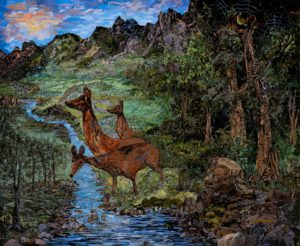
“The Katahdin Valley, Maine” by George Sakkal
Modern art extends from about the 1860s to the 1970s, followed by the Postmodern era. Even so, modern and postmodern art timelines overlap extensively. What sets them apart is actually the art theory that works behind them. While the postmodern art theory of Marcel Duchamp in the early 1900s created a myriad of unique art forms, the modern art theory of Paul Cezanne decades earlier set a completely different tone.
The Modern Art Theory of Paul Cezanne
Paul Cezanne is considered to be the “father of modern art” due to his originality amid the Impressionist art movement. As a post-Impressionist artist, he broke away from the methods of his contemporaries and paved the way for the modernist era. Cezanne painted in bright, bold brushstrokes that emphasized the basic structures of objects while still maintaining the depiction of light through color that was famous among the Impressionists.
The modern art theory of Paul Cezanne that transformed the direction of fine art was the idea that the artist produced visual fine art through the subconscious mind. Decisions about what colors to use, how to apply them, and what the work came to be as a whole happen subconsciously. It is a process of discovery rather than a conscious act. This theory is opposed to the postmodern art theory of Marcel Duchamp, which claimed that one produces fine art through conscious decision-making.
How CUVISM Supports the Modern Art Theory
Theories are only theories until supported by scientific evidence. The discovery of CUVISM, Cognitive Unconscious Visual Creativity, by collage artist George Sakkal, displays how every artist has the subconscious ability to create fine art. CUVISM is not another “-ism;” rather, it is the name for the process that happens within the brain when creating visual fine art. It is a purely subconscious act, fueled by the knowledge and experience gathered and stored in the memory, and every artist possesses it.
It is due to the development of neuroscience in the 1980s and the research of George Sakkal that this discovery is uncovered. For the first time, science meets art in the evidence of CUVISM in the artistic process. When the artist outpours visual creativity from the subconscious, it is the subconscious brain that is at work, evidencing that Cezanne’s modern art theory is correct.
Modern Art Theory at Work
What does art become when working through the art methodology of CUVISM? What is fine art in modern art theory? Artist George Sakkal’s works are tangible evidence of CUVISM at work; ranging from realism to abstract expressionism, Sakkal’s works encompass a diverse portfolio of imaginative pieces covering many notable subjects, all produced from the subconscious mind.
Explore the Art and Works of George Sakkal
CUVISM engages by way of a search and discover methodology. It totally rejects Postmodernism’s predeterminate readymade ideology; a conscious mind preconceived conceptual art theory, a theory and practice Sakkal has proven to be fallacious and damaging to the creative mind of all artists who subscribe to its use. To learn more about CUVISM, acquire George Sakkal’s 2015 book, CUVISM: Cognitive Unconscious Visual Creativity The Human Response, available at amazon.com, and his new book, WHOSE TRUTH– WHOSE CREATIVITY?, Why Postmodern Art Theory is a Cultural Damaging Hoax and How Neuroscience Can Prove This, A 21st CENTURY ART MANIFESTO. His new book is available at most bookstores and from Amazon.com.